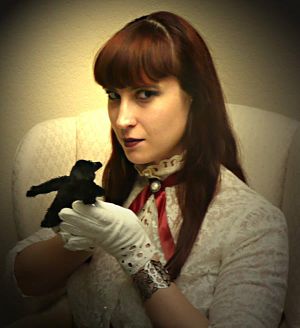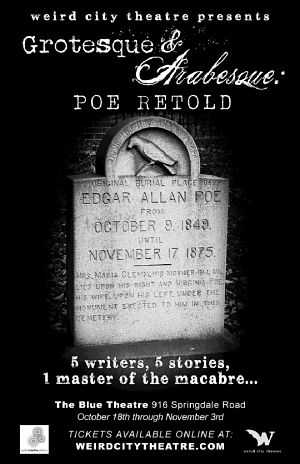Review: Grotesque and Arabesque - Poe Retold by Weird City Theatre
by David Glen Robinson
I keep hearing the BLUE Theatre is closed or closing, but I keep going there to shows, despite the construction and demolition all around it. Now Weird City Theatre has installed in it Grotesque and Arabesque: Poe Retold, a bold collection of five one-acts abstracted from five of Poe’s horror stories. The story treatments were written by Weird City Theatre company members or associates, and they arrive on stage as one-act plays just in time for weird Austin’s favorite holiday.
Full disclosure: Poe is my favorite author, and I admit as much in my Facebook profile. So my expectations were sky-high when I entered the theatre. The adaptations are of well-known horror stories that I have read many times. I knew Weird City Theatre had the guns to deal with their self-appointed tasks; they specialize in plays dealing in pop culture genres, such as goth, vampire and zombie themes. They offered two particularly memorable stage versions of Night of the Living Dead in 2008 and in 2011 and also William Gillette’s Sherlock Holmes in 2009.
 Carl G. Jung's definition of archetypes assists in enjoying good art. He talked about archetypes as forms, probably arising from the unconscious, that continue through time and offer unbounded opportunity for creative play. Multiple times and diverse cultures rediscover them as their own and play with them in different modes, making them the vehicles for their perpetuation. Edgar Allan Poe clearly and intuitively tapped into archetypes; that’s why he can give us the ever-famous frisson of horror when we read his stories. Does the same hair-raising, shivering, why-did-I-come-here reaction take place when the story medium transmutes to the medium of the stage? That might be the standard of evaluation for Weird City Theatre’s production.
Carl G. Jung's definition of archetypes assists in enjoying good art. He talked about archetypes as forms, probably arising from the unconscious, that continue through time and offer unbounded opportunity for creative play. Multiple times and diverse cultures rediscover them as their own and play with them in different modes, making them the vehicles for their perpetuation. Edgar Allan Poe clearly and intuitively tapped into archetypes; that’s why he can give us the ever-famous frisson of horror when we read his stories. Does the same hair-raising, shivering, why-did-I-come-here reaction take place when the story medium transmutes to the medium of the stage? That might be the standard of evaluation for Weird City Theatre’s production.
And, oh my! The experiment succeeded, the subject survived—now it lives among us. Thee short pieces ranged from clever to brilliant in their imagining and writing, while the staging and realizations varied a little more widely in their successes. One of the cleverest concepts in the show was a series of vignettes and considerations of the true-life story of the Poe Toaster, the mysterious figure, never identified, who from the 1930s to the late 1990s placed roses and a bottle of cognac at Poe’s grave monument in Baltimore. He or she was said by observers to visit the cemetery every year on Poe’s birthdate in the wee hours and perform small personal rituals and raise a toast in cognac to the gravestone. He or she then departed from the cemetery, leaving behind the cognac and roses. Weird City uses this story as a connecting thread between the pieces, showing us four different treatments of it, with dialogue considerations of the Poe and his Toaster all the while. I especially appreciated the last piece in this miniseries, featuring Kevin Gouldthorpe’s soliloquy on Poe as “beautiful but never pretty” and a man holding up a mirror to us in our most private moments. The stage artists showed profound respect for the literary artist, expressed in the best way they knew how to express it—on stage. At that moment I knew I could trust Weird City with my Poe.
The first one-act was The Case of M. Valdemar, adapted by Terri Lynne Hudson from The Facts in the Case of M. Valdemar. Hudson also played the title role. The play was remarkable for applying Poe’s nineteenth century literary approach of explaining at length the justification of the practices applied in the plot, in this case mesmerism. For the stage, this exposition was assisted by projected images of Dr. Mesmer himself and copies of Renaissance drawings of the body and its humors. Chris Romani performed lapidary work in getting through this material and setting us down on the near-corpse of Valdemar. Something I think was a deviation from Poe’s text, however, was Valdemar’s habit of giving asides to the audience, revealing that she was an unwilling subject of the experiment. Her lines did not interrupt the slow build-up of horror in any case. Poe was said by many to be an innovator of the short story form; he emphasized the story structure of placing a story’s climax at the very end of the tale, with a steady emotional climb to it. This was how Poe wrote The Facts in the Case of M. Valdemar, to powerful effect. And here Hudson strayed slightly; the playlet ended with more of Valdemar’s asides to the audience; instead, and very clearly, the character of Valdemar should have been away exploring the thanatopic realm, thoroughly heedless of mortals, the play ending strictly on the “detestable putridity”[1] of her exit.
The Cask of Amontillado followed Valdemar. Surprise -- it was a short film, not a one-act play as I had believed up until I bought my ticket and received my program. The film was by John L. Carroll and starred Kevin Gouldthorpe as Montressor and John W. Smith as Fortunato, respectively the murderer and his victim. The screenplay was very well adapted from the story of the same name, and it provided impressive solutions to the technical problems presented by the story, these being cavernous stone galleries below ground, prevailing darkness, and permission to build a stone wall across a gallery mouth. The credits explained it all, stating that the work was filmed at Longhorn Caverns State Park. Carroll chose to keep the story in its medieval/Renaissance historical context, conveying the period with costumes, period props and abundant crumbling stone architecture. He played it all very straight and won. Carroll clearly trusted his material.
Masque was adapted from the revered Masque of the Red Death, the fantasy-horror tale of Death’s commanding presence at a royal masqued ball. Director Patti Neff-Tiven and the cast are credited with the adaptation. This playlet also stayed true to the story’s setting, progress and text. Projected images of the text and voice-overs assisted and accelerated the plot. Here I would have liked to see more intentional, patterned choreography. A few phrases of group unison movement in the modern style yet evocative of court dances would have solidified the imaginative setting of the piece and given us something distinct from other pieces in the show. And such work would not have been beyond the abilities of this group of competent movers.
Robert L. Berry adapted The Tell-Tale Heart from the short story of the same name. Adapting it was one of the easiest jobs in the show, for the story text is entirely the internal dialogue of a confined lunatic. Berry, appearing as the lunatic, lifted large chunks of the text and shifted the setting to a modern mental hospital. This method kept the playlet unquestionably true to the text and its deep psychological horror. I especially appreciated the twenty-first-century updating of the staging: a hospital orderly focused a video minicam on the face of the patient to record his therapeutic declamations (read: ravings) on the crime. The video was projected real-time on a screen upstage, giving super close-ups of the insanity. From where I sat in the audience, the video image frequently completely encompassed the head and figure of the actor, creating a dome of madness over the character more confining and inescapable than any physical restraints could ever be. Even while Berry was n full rave, his diction was excellent. I would have preferred a slightly slower emotional build-up to the climactic insane rampage, but Berry’s strong performance is thoroughly admirable and memorable. A note to the lighting operator: the critical blackout could have happened faster.
Hop-Scotch was adapted by Sean McGrath from the chilling Hop-Frog and transferred from a fantasy medieval court to the twenty-first century playground. Despite the radical change of setting, the piece seems truer to the spirit of the Poe story than any of the other playlets in the show. The story’s core themes of the inherent cruelty of humanity and revenge, revenge and revenge are thoroughly intact and well illuminated. McGrath’s confidence is revealed by his interjection of out-of-time, internal ravings of teacher Mrs. King (Kevin Gouldthorpe), depicting her as about-to-go-postal. The injection of this wild humor works screamingly well alongside the piece’s darker themes, as does the partially drag, faux all-female cast.
All the pieces deal with death, as most horror stories do, and deliberately or not, they also seem to echo Poe’s suggestion that death has its own peculiar sweetness and desirability. Poe, who died at forty and never grew old, wrote more than once of the refuge of death, characterizing it variously as a balm, a place of asylum and occasionally as a sanctuary of impunity appealing to the despondent, the demented and those guilty beyond redemption.
Often, theatre companies are filled with degreed actors and technicians devoted to drama and to their professional careers. Weird City Theatre has a few of these, but it is crowded mostly with those in love with performance and with the literary genres it stages regularly. They may also sense and play with the archetypes found in such material. Weird City’s performers want nothing more than participation in these stories. This sustaining passion comes through all the company’s work, and, I believe, gives it the courage necessary for its bold offerings.
Embracing Edgar Allan Poe’s work certainly requires courage as well as love. This creative play with the archetypes summoned by Poe amounts to holding that mirror up and close. It is nothing less than surrendering to the monstrous forms that rise from the abyssal dark of Poe’s oceanic imagination. I respect Weird City Theatre’s immense artistic courage in launching out upon those waters.
[1] Edgar Allan Poe. The Viking Portable Library. The Viking Press. New York. P. 280.
Hits as of 2015 03 01: 3265
Grotesque and Arabesque - Poe Retold
by Edgar Allan Poe, adapted by Weird City Theatre ensemble
Weird City Theatre
Springdale Rd and Lyons
behind Goodwill warehouse
Austin, TX, 78702
